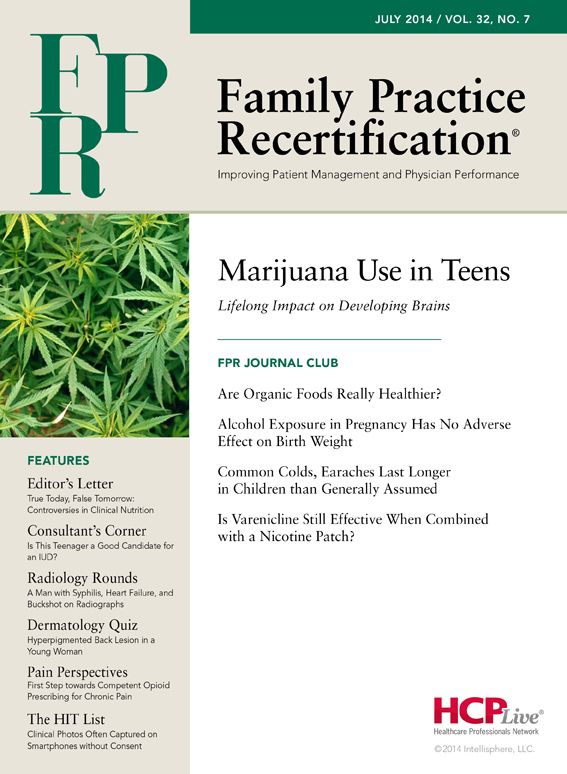Publication
Article
Marijuana Use Has Lifelong Impact on Developing Brains
Author(s):
Marijuana use in adolescence results in significant cognitive and behavioral impairments.
Frank J. Domino, MD
Review
Dougherty DM, et al. Impulsivity, attention, memory, and decision-making among adolescent marijuana users. Psychopharmacology (Berl). 2013 Mar;226(2):307-19. http://www.ncbi.nlm.nih.gov/pubmed/23138434.
This was a case-controlled study to determine the associations among marijuana use and performance in multiple cognitive and behavioral domains — including attention, memory, decision-making, and impulsivity — in 14- to 17-year-olds.
Study Methods
Regression analyses of 45 marijuana-using adolescents and 48 control subjects were conducted to determine:
- Differences between marijuana users and nonusers in each cognitive and behavioral domain.
- Associations among marijuana use and each domain after controlling for the other domains.
- The degree to which the above 2 analyses described differences among marijuana users and nonusers.
Results and Outcomes
Of the tested cognitive and behavioral domains, impaired short-term recall memory and “consequence sensitivity impulsivity”, or the ability to delay gratification, were associated with marijuana use after controlling for performance across all measures.
Conclusion
Marijuana use in adolescence results in significant cognitive and behavioral impairments.
Commentary
As marijuana use has been approved for medical purposes and legalized in some states, concerns have risen regarding the drug’s consequences, and this study specifically targets its influence on a number of behavioral and cognitive domains in adolescent patients.
The authors noted significant deficits in marijuana-using adolescents, particularly in the areas of memory and impulsivity. They also found the earlier the age of exposure to marijuana, the greater the impact on adverse outcomes.
This outcome is most worrisome, as adolescents already have a high baseline risk for impulsive behaviors, with suicide being the most pronounced example. In 2014, the US Centers for Disease Control and Prevention (CDC) deemed suicide the leading cause of injury mortality in the United States among teens and adults.1 Since marijuana use increases this impulsivity, it will likely worsen the risk of suicide.
According to an annual survey funded by the National Institute of Drug Abuse (NIDA), marijuana use among adolescents has increased over the last 20 years. In 2013, 7% of eighth graders, 18% of tenth graders, and 22% of twelfth graders had used marijuana within the past month. Additionally, 6.5% of twelfth graders indicated using marijuana every day, compared to <5% just 5 years earlier.
As the rate of marijuana use increases, the perception of the drug’s risk diminishes, according to a 2013 NIDA-funded survey.

Despite the increased use of hookah water pipes and small cigars among adolescents, the survey also found more twelfth graders use marijuana than cigarettes.

While the current study was small, it began to describe what many physicians fear: marijuana use has a significant and lifelong impact on the developing brain. Other known trends in marijuana use include a significant detrimental impact on executive functioning that is closely tied to age of onset. A recent study found marijuana use before age 16 produced the greatest detrimental effect,2 including an increased risk for schizophrenia.3
As marijuana becomes more legally available, family physicians must aggressively counsel against its use among adolescents and parents alike, who often condone its use, as it will impart a lifetime of morbidity on the developing brain. Whether marijuana is a “gateway drug” is up for debate, but there seems to be little doubt that the initiation of its use in adolescence is dangerous. As healthcare professionals, family physicians must take the lead in describing this risk as frequently as they encourage the use of seatbelts and discourage the use of tobacco.
References
1. Haegerich TM, et al. Prevention of injury and violence in the USA. Lancet. 2014 Jul 2;384(9937):64-74. http://www.thelancet.com/journals/lancet/article/PIIS0140-6736(14)60074-X/fulltext.
2. Gruber SA, et al. Age of onset of marijuana use and executive function. Psychol Addict Behav. 2012 Sept;26(3):496-506. http://www.ncbi.nlm.nih.gov/pubmed/22103843.
3. Evins AE, et al. Does using marijuana increase the risk for developing schizophrenia? J Clin Psychiatry. 2013 Apr;74(4):e08. http://www.ncbi.nlm.nih.gov/pubmed/23656852.
About the Author
Frank J. Domino, MD, is Professor and Pre-Doctoral Education Director for the Department of Family Medicine and Community Health at the University of Massachusetts Medical School in Worcester, MA. Domino is Editor-in-Chief of the 5-Minute Clinical Consult series (Lippincott Williams & Wilkins). Additionally, he is Co-Author and Editor of the Epocrates LAB database, and author and editor to the MedPearls smartphone app. He presents nationally for the American Academy of Family Medicine and serves as the Family Physician Representative to the Harvard Medical School’s Continuing Education Committee.






